Construction of Laneway at Lea Townland Portarlington
Date: 14/05/2021
Project Funded by The Heritage Council

www.colmflynnarchaeology.ie
1.0 Introduction
The Lea Castle Conservation Group has been involved in promoting and protecting the archaeological and natural heritage of Lea Castle and its environs for over 10 years. As part of the group’s commitment to the continued enhancement and improvement of access to the archaeological heritage of Lea and its environs, the group carried out the Lea Graveyard Accessibility Project 2021. This project saw the construction of a stone laneway at Lea townland, Portarlington Co. Laois, by contractors on behalf of the Lea Castle Conservation Group. This work took place in April and May 2021. All of the works were carried out under the terms of the National Monuments Acts (1930-2014), and in accordance with the document Frameworks and Principles for the Protection of the Archaeological Heritage (1999). The work was carried out as part of a Community Heritage Grant Scheme issued by the Heritage Council. The works were completed by construction contractors acting for the Lea Castle Conservation Group. The works took place in the vicinity of several known archaeological sites that are contained in the Record of Monuments and Places and consequently afforded legal protection under the National Monuments Acts (1930- 2014). Due to the proximity of the works to these known archaeological sites, archaeological supervision was provided by the author.
2.0 Description of the Site
The laneway that was subject to the resurfacing works outlined in this report is situated in Lea townland and appears on the 19th-century Ordnance Survey maps of the area. This laneway was part of a routeway that linked the medieval church and graveyard at Loughmansland Glebe (RMP No LA005-007 and LA005-007001) with the Anglo-Norman castle at Lea (RMP No LA005-006). This routeway predates the establishment of the town of Portarlington, and likely is contemporary with the founding of the medieval manor at Lea.
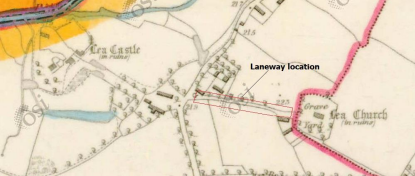
Figure showing the location of laneway on 1st ed 6” to a mile scale OS map
3.0 Description of the Works
Prior to the commencement of works, the construction contractor and the author inspected the receiving environment. This was carried out to ensure that no archaeological features would be impacted by the works. The laneway had become overgrown with detritus and some hedges over recent times. Although the graveyard at Loughmansland Glebe was in use until the late 20th century, access to the graveyard along the laneway has not been maintained.
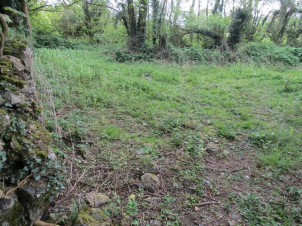
Showing laneway prior to commencement of works, facing south.
The construction contractor used a 3.5tn machine equipped with a toothless grading bucket to remove the vegetation from the laneway. This resulted in minimal disturbance of the existing ground material. Where exposed, the topsoil (C01) was mid-browne fine silt.
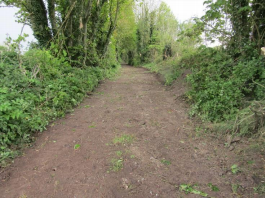
Showing laneway after removal of detritus, facing east.
Once the contractor had completed the removal of detritus, the author inspected the laneway to ensure that no archaeology was exposed. Following this, the construction contractor commenced the mechanical laying of engineered stone (clause 804 stone) along the laneway. This work commenced at the west end, nearest the public road, and worked eastwards towards the church and graveyard.
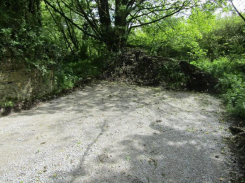
Showing laneway at graveyard after laying of engineered stone, facing south.
When the stone had been laid along the entire laneway, the contractor used a mechanical roller to compact the stone, thus limiting the ability of vegetation to re-establish along the laneway.
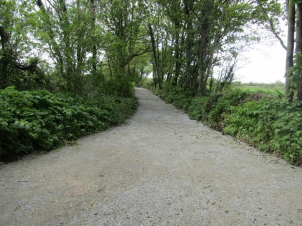
Showing laneway following compaction of engineered stone facing west.
4.0 Conclusions
Lea Castle Conservation Group applied to the Heritage Council through Laois County Council to carry out the Lea Graveyard Accessibility Project 2021, which saw resurfacing of a laneway in Lea townland, Portarlington, Co. Laois. The objective of the project was to enhance accessibility to the medieval church and graveyard at Loughmansland Glebe, Portarlington.
Works were carried out by construction contractors in April and May 2021. The resurfacing and compaction of engineered stone along the laneway has increased accessibility for visitors to the site and added to the upkeep and amenity value of the area.
No archaeological features and no artifacts were identified during the works
